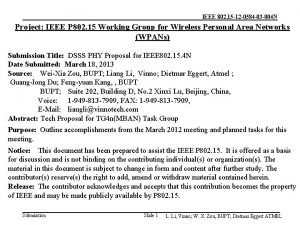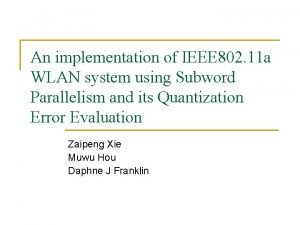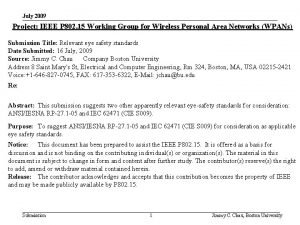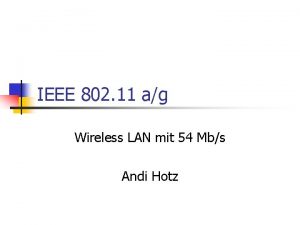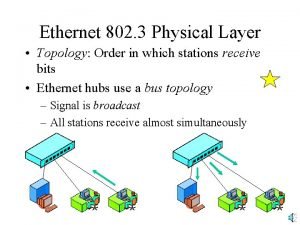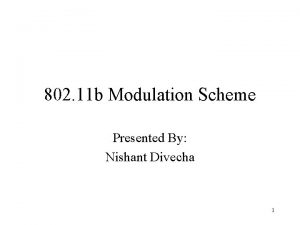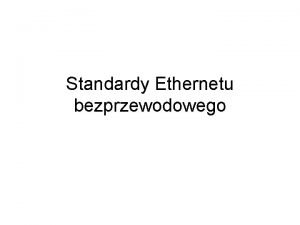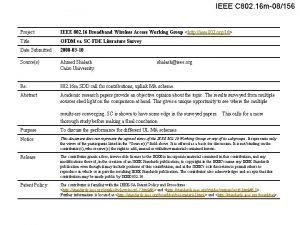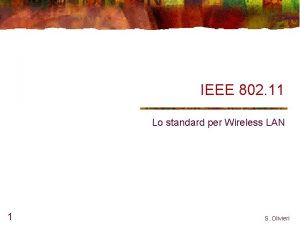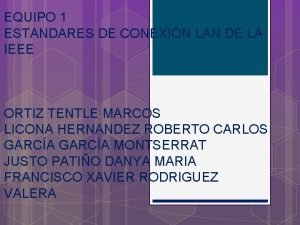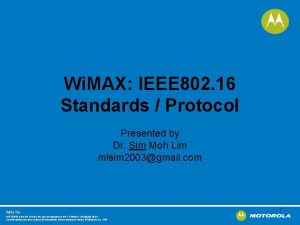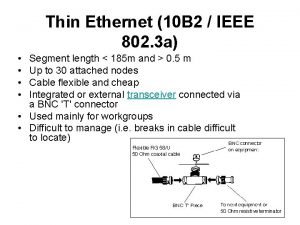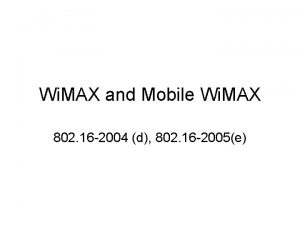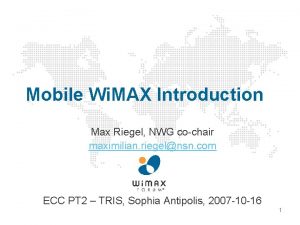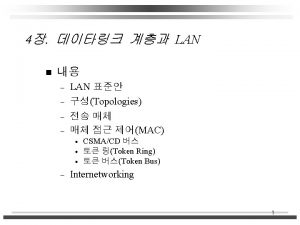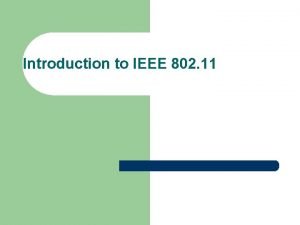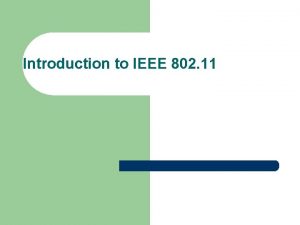Introduction to Wi MAX IEEE 802 16 and








































- Slides: 40

Introduction to Wi. MAX (IEEE 802. 16) and 3 GPP LTE-A 2020/12/5 1

Outline o Wi. MAX 介紹 o n IEEE 802. 16 網路架構型態 o n TDD & FDD, 調變, OFDM & OFDMA, Frame structure 3 GPP LTE 簡介 n n o CS、CPS、PS三種子層, Qo. S 類別, Handoff 機制, 省電模式 IEEE 802. 16 Physical layer o o PMP architecture, Relay architecture, MESH architecture IEEE 802. 16 MAC layer o n 由來, Wi. MAX Forum組織, 標準發展, 802. 16 標準比較 網路架構 省電模式 Wi. MAX的相關研究

(1) Wi. MAX 介紹 o Wi. MAX (Worldwide Interoperability for Microwave Access)”全球微波互通存取” o 基於IEEE 802. 16 standard的無線存取標準 o 屬於”大都會區域網路”(Metropolitan Area Network, MAN),特色為長距離傳輸(up to 30 miles)及高頻寬 傳輸(up to 70 Mbps) o 提供最後一哩網路存取之方案 2020/12/5 3

(1) Wi. MAX 介紹 o 目前分成固定式 Wi. MAX 及移動式 Wi. MAX o 固定式 Wi. MAX: n o 以 802. 16 -2004 (IEEE 802. 16 d) 為主,2004 年獲 IEEE 核准。 移動式 Wi. MAX: n 以 802. 16 -2005 (IEEE 802. 16 e) 為主,2005獲 IEEE 核准。主 要競爭對手為 3 GPP。 2020/12/5 4


(2) 標準發展狀況 LTE-Adv 4 G 802. 16 j 2020/12/5 802. 16 m 6

(2) IEEE 802. 16 標準比較 standard 802. 16 d-2004 802. 16 e 802. 16 j 應用模式 固定式應用 (取代寬頻設備) 移動式應用 應用方向 Last Mile & Backhaul Mobile Device 10~66 GHz (SCM) 頻段 傳輸條件 LOS 傳輸速率 32~134 Mbps 2~11 GHz (OFDM, OFDMA) 75 Mbps 35 Mbps >35 Mbps 350 Mbps QPSK、16 QAM、64 QAM 固定/ 移動性 註: 1 mile= 1. 6 Km, 2020/12/5 2~6 GHz (4 x 4 MIMOOFDMA) NLOS 調變技術 傳輸距離 2~6 GHz (OFDMA) 802. 16 m 固定性 1~3 Mile 4~6 Mile (最大 30 Mile) 移動性 (60~120 km/h) 移動性 (350 Km/h) 1~3 Mile LOS (Line of Sight) :可直視範圍的直線傳輸 7

Outline o Wi. MAX 介紹 o n IEEE 802. 16 網路架構型態 o n TDD & FDD, 調變, OFDM & OFDMA, Frame structure 3 GPP LTE 簡介 n n o CS、CPS、PS三種子層, Qo. S 類別, Handoff 機制, 省電模式 IEEE 802. 16 Physical layer o o PMP architecture, Relay architecture, MESH architecture IEEE 802. 16 MAC layer o n 由來, Wi. MAX Forum組織, 標準發展, 802. 16 標準比較 網路架構 省電模式 Wi. MAX的相關研究

(4) IEEE 802. 16 網路架構型態 o 根據應用需求及覆蓋範圍 n IEEE 802. 16 支援 3種網路架構 o Wi. MAX Network Architectures 1) 點對多點架構(Point-to-multipoint, PMP) n o 2) 中繼網路架構(Relay architecture) n o IEEE 802. 16 d/e IEEE 802. 16 j 3) 網狀網路架構(Mesh architecture) n IEEE 802. 16 d




Outline o Wi. MAX 介紹 o n IEEE 802. 16 網路架構型態 o n TDD & FDD, 調變, OFDM & OFDMA, Frame structure 3 GPP LTE 簡介 n n o CS、CPS、PS三種子層, Qo. S 類別, Handoff 機制, 省電模式 IEEE 802. 16 Physical layer o o PMP architecture, Relay architecture, MESH architecture IEEE 802. 16 MAC layer o n 由來, Wi. MAX Forum組織, 標準發展, 802. 16 標準比較 網路架構 省電模式 Wi. MAX的相關研究












Outline o Wi. MAX 介紹 o n IEEE 802. 16 網路架構型態 o n TDD & FDD, 調變, OFDM & OFDMA, Frame structure 3 GPP LTE 簡介 n n o CS、CPS、PS三種子層, Qo. S 類別, Handoff 機制, 省電模式 IEEE 802. 16 Physical layer o o PMP architecture, Relay architecture, MESH architecture IEEE 802. 16 MAC layer o n 由來, Wi. MAX Forum組織, 標準發展, 802. 16 標準比較 網路架構 省電模式 Wi. MAX的相關研究



(6) IEEE 802. 16 Physical layer o 調變機制 (Modulation and coding schemes, MCSs) n n 支援種類:QPSK (Quaternary Phase Shift Keying)、16 QAM(16 Quadrature Amplitude Modulation、64 QAM (Quadrature Amplitude Modulation) 特徵: o o 較高SNR值可達到較高的調變在相同的符元時間(Symbol Time)攜帶較高的資料位元數 速率編號 調變方式 編碼率 攜帶位元數/符元時間 (bits/symbol) SNR值門檻 1 QPSK 1/2 1. 0 6 d. Bm 2 QPSK 3/4 1. 5 8. 5 d. Bm 3 16 QAM 1/2 2. 0 11. 5 d. Bm 4 16 QAM 3/4 3. 0 15 d. Bm 5 64 QAM 2/3 4. 0 19 d. Bm 6 64 QAM 3/4 4. 5 21 d. Bm n表: IEEE 802. 16支援的六種調變編碼

(6) IEEE 802. 16 Physical layer o PMP網路架構下的訊框(Frame structure) n 2維訊框:由frequency domain的subchannel 和time domain的time-slot組成 o o 每個frame分成uplink subframe及downlink subframe 每個downlink subframe,包含 n n n o Preamble (用於time synchronization) Control portion o 包含:downlink map (DL-MAP)及uplink map (UL_MAP) o 目的:指示donwlink及uplink的資源配置 Data portion o 包含:多個bursts o Burst是配置給MSS最基本的單元,以矩形方式出現 每個uplink subframe只含data portion n Uplink的burst是以”列優先”排列 圖:PMP網路架構下的訊框

(6) IEEE 802. 16 Physical layer o PMP網路架構下的訊框(Frame structure) n 每個burst: o n 每個IE: o o 有一種調變(MCS),利用information element (IE)來指定位置及大小 需要60 bits(使用最低調變QPSK 1/2),佔 5/4個slot 結論:IE和burst共用downlink subframe,過多的IEs會降低網路的傳送效益。 圖:PMP網路架構下的訊框

(6) IEEE 802. 16 Physical layer o Relay網路架構下的訊框(Frame structure) n n 2維訊框 (同前,因採OFDMA技術) 含兩種frame:一為BS frame,二為RS frame,兩者具”互補性” o BS frame: n n o 在downlink subframe,BS-MSS/RS region可配置burst傳送資料給MSSs或RSs 在uplink subframe,MSS-BS及RS-BS region可配置burst給MSS及RS傳送資料給BS。 RS frame: n n 在downlink subframe,RS-MSS region可配置downlink burst讓RS傳送資料給MSSs 在uplink subframe,MSS-RS region可配置bursts讓MSS透過RS傳送資料給BS 圖:Relay網路架構下的訊框(Frame structure)

(6) IEEE 802. 16 Physical layer o Relay網路架構下的訊框(Frame structure) n 每個RS是視為”bufferless” o o n RS從MSS及BS收到的資料必須在同一個frame傳遞給BS及MSS。 舉例:有一個Burst(MSS 1 -RS 1)配置在MSS-RS region,因此必定有一個burst (RS 1 -BS)對應在 RS-BS region。 Burst是否可重疊: o o 是:位於RS-MSS及MSS-RS regions的bursts可能可重疊,利用spatial reuse 否:任兩個burst位於BS-MSS/RS region無法重疊,因BS是RS們唯一的接收端 圖:中繼網路架構 (Relay Architecture) 圖:Relay網路架構下的訊框(Frame structure)

(6) IEEE 802. 16 Physical layer o Mesh網路架構下的訊框(Frame structure): n n 1維訊框 (因使用OFDM),最基本配置單元:”mini-slot” 定義兩種型態的frame: o Type-1 frame (含一個network control subframe及一個data subframe) n 目的:提供network 參數設置 n network control subframe : o o n 長度固定 攜帶一些”網路資訊”,如:network topology的資訊。 data subframe : o o 攜帶SS的bursts guard time:burst傳遞前必須等待的一段時間用於同步及避免前面burst對後面burst產生 propagation的影響。由於無法傳遞資料,視為一種transmission overhead 圖:Mesh網路架構下的訊框(Frame structure)

(6) IEEE 802. 16 Physical layer o Mesh網路架構下的訊框(Frame structure): o Type-2 frame (含一個schedule subframe及一個data subframe) n n 目的:資料排程 schedule subframe: o o n n 長度固定 包含scheduling information,如:傳/收對象,及burst傳送的mini-slot數目 data subframe:同上 結論: o Guard time次數增加,會造成network performance下降。 n 如何減少此類overhead是一個重要的議題。 圖:Mesh網路架構下的訊框(Frame structure)

Outline o Wi. MAX 介紹 o n IEEE 802. 16 網路架構型態 o n TDD & FDD, 調變, OFDM & OFDMA, Frame structure 3 GPP LTE 簡介 n n o CS、CPS、PS三種子層, Qo. S 類別, Handoff 機制, 省電模式 IEEE 802. 16 Physical layer o o PMP architecture, Relay architecture, MESH architecture IEEE 802. 16 MAC layer o n 由來, Wi. MAX Forum組織, 標準發展, 802. 16 標準比較 網路架構 省電模式 Wi. MAX的相關研究

(7) 3 GPP LTE-A網路架構 o PMP architecture: o Relay architectures:

(8) LTE-A省電機制(Power Saving Mechanism) o Mechanism:Discontinuous Reception/Transmission (DRX/DTX) n n Two kinks of cycles, (a cycle with one listen window and one sleep window ) o Short Cycle o Long Cycle Two kinks of timers (s-timer, l-timer) 37

(8) LTE-A省電機制(Power Saving Mechanism) The Operation of DRX short cycle: 38

(8) LTE-A省電機制(Power Saving Mechanism) The trigger of DRX long cycle: 39

Thank You. Q&A
 Bridges from 802.x to 802.y
Bridges from 802.x to 802.y Bridges from 802.x to 802.y
Bridges from 802.x to 802.y Modelo ieee 802
Modelo ieee 802 802 ieee
802 ieee Ieee 802 family
Ieee 802 family Ieee802.22
Ieee802.22 Ieee 802 standard
Ieee 802 standard Ieee 802
Ieee 802 Ieee 802 3 compliance
Ieee 802 3 compliance Arquitetura ieee 802
Arquitetura ieee 802 802 15
802 15 Local maximum
Local maximum Weber sociology
Weber sociology Mac address
Mac address 802 15
802 15 Project 802
Project 802 Wlan 802
Wlan 802 Geo 802
Geo 802 Filler 602
Filler 602 09 802 0561
09 802 0561 Project 802
Project 802 802-11-wireless-security
802-11-wireless-security 802 5
802 5 Wireless lan 802
Wireless lan 802 802 3
802 3 802 eap
802 eap Sybex ccna
Sybex ccna 802 3
802 3 802 16
802 16 802 11
802 11 Ssin-802
Ssin-802 802 11 b
802 11 b Standardy 802
Standardy 802 802 701
802 701 507-802-380
507-802-380 Nn dfe
Nn dfe 802 protocols
802 protocols 802/11
802/11 Estandares 802
Estandares 802 802 16
802 16 802-3-ethernet
802-3-ethernet














